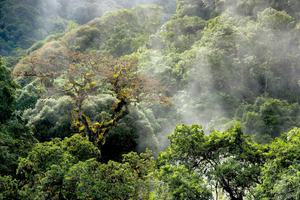The Tumba-Ledima Reserve in the Democratic Republic of Congo. Ollivier Girard/CIFOR
One-third of — or more 7,000 — plant species in tropical Africa could be at risk of extinction due to climate change and human activities like logging, deforestation from agriculture, and mining, according to a new study published in the journal Science Advances. Another third are likely rare, meaning they could be threatened with extinction in the near future.
The research identified four regions in tropical Africa where plant species are most at risk: Ethiopia, central Tanzania, the southern Democratic Republic of the Congo, and the West African tropical rainforests.
The study, led by scientists in the United States and Europe, examined 600,000 location records for more than 20,000 plant species across tropical Africa. Typically, species status is evaluated by a standardized procedure developed by the International Union for Conservation of Nature (IUCN). But these assessments can only be done on a species-by-species basis and require in-depth knowledge of IUCN’s Red List criteria for designating a species as threatened. As a result, while 86 percent of mammal and 61 percent of bird species globally have been evaluated, fewer than 8 percent of the estimated 352,000 plant species worldwide have.
The new study presents a new way to automatically determine the conservation status of a large number of plant species over a broad area, the scientists said. “These assessments could provide crucial information for improving biodiversity management and promoting sustainable economic development in Africa,” botanist Thomas Couvreur from the French Research Institute for Development, lead author of the study, said in a statement. “They are, however, not intended to replace the comprehensive assessments carried out by the IUCN which lead to official statuses. The two approaches are complementary, and a significant international effort is still needed to assess all plant species in Africa.”



